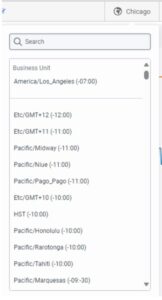Work with forecasts
Forecasts help you plan how many interactions to expect in future weeks. Forecast data includes such metrics as pattern, volume (interactions offered), and average handle time (composed of average talk time, average hold time, and average after call work time). These forecasts are visible in two views. The short-term forecast view shows interval-level data for one week at a time for up to six weeks, depending on the length of the forecast, and can be used to generate schedules. The long-term forecast view shows day- and week-level data for up to one year at a time, for up to two years depending on the length of the forecast. This view helps the forecaster see seasonality and trends but cannot be used to generate schedules.
- Structure business units with a clear separation of resources and load to ensure that no shared load exists across business units. If you cannot guarantee a separation of resources and workload, administrators must manually adjust forecasts each week to account for a percentage of allocated volume handled by a different business unit.
- Schedules can only be generated based on the short-term component of a forecast, which has a maximum of six weeks. Scheduling for more than six weeks in the future requires multiple forecasts.
The forecasts list displays up to a maximum of 26 weeks prior and 26 weeks forward from the earlier of the current week or the last week in which a forecast exists. Use the search feature to find forecasts, including those outside the +/- 26-week window.
| Column | Description |
|---|---|
| Add | Create a new forecast. |
| Search | Each column contains a search text box or a list of options by which to filter the items. Depending on your view, locate the category by which you want to filter and do one of the following:
|
| Refresh | Refresh the list of displayed forecasts. |
| Start Date | Open a forecast by clicking an item in the list. |
| Number Of Weeks | The number of weeks in the forecast range. |
| Short-Term Weeks | The number of weeks that you can use for scheduling purposes. |
| Date Modified | The last date and time the forecast was modified. |
| Available for Schedule |
Enable the check box to indicate that this forecast is available for schedule generation. Note: If you do not enable this check box, the forecast does not appear as an option in schedule generation. |
| Date Created | The date and time that a user created the forecast. |
| Date Modified | The date and time that a user modified the forecast. |
| Modified By | The name of the person who last modified the forecast. |
| Description | Descriptive information about the forecast, if entered. |
| Creation Method |
The forecasting method used to generate the forecast: Automatic Best Method Selection, Weighted Historical Index, Weighted Historical Index with Source Data Import, or Import Forecast Data. Click any forecasting method, excluding Import Forecast Data, to view details about planning groups, metrics, forecasting method, and forecast type included in the forecast. |
| Delete all selected | When you select one or more schedules, the Delete all selected option appears. Click it to remove the schedules. |
| More | Click this button and from the menu that appears, select Show/Hide Columns or Reset Defaults. These options allow you to add or hide more columns, or reset the view to default settings. |
View from a different time zone
By default, this view uses the business unit’s time zone. Users with administrator permissions can change the displayed time zone by selecting from the list in the upper right corner of the view. The time zone of the business unit is listed at the top of the list of time zones for reference. This option is helpful for administrators who access the view from a different time zone. Click the image to enlarge. 
For more information about forecasts, see the tasks outlined in the following articles.
| Task | Description |
|---|---|
| Navigate the forecast | View information about the expected interactions offered, analyze forecast metrics, export forecast and source data, manage forecast modifications, and filter information by metrics, days, queues, media types, and skill set. |
| Add a forecast | Add a new forecast, configure a work plan, and configure the forecast week, description, and data source. |
| Filter and sort workforce management items | Depending on your view, you can narrow or categorize workforce management items for search purposes. |
| Export a forecast | You can export a forecast and download the information in CSV format for importing into future forecasts. The system enables you to export the forecast data in the desired time zone. |

